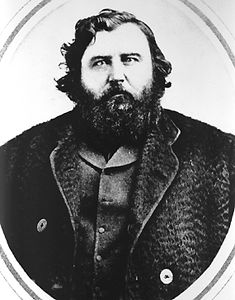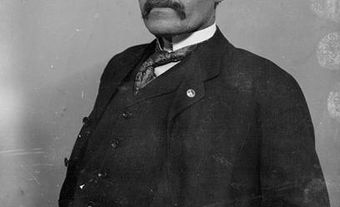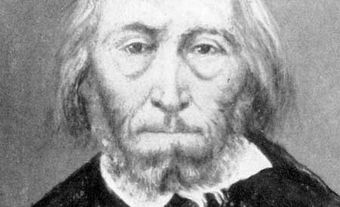
Early Life and Education
James McKay was born at Edmonton House, also known as Fort Edmonton, a Hudson’s Bay Company (HBC) trading post in what is now central Alberta, in 1828. He was the namesake oldest son of a Scottish boat-brigade guide who worked for the HBC, and Métis mother Marguerite Gladu. McKay had three brothers: John (born in 1831), George (1833) and Angus (1835).
McKay received his education at Red River Academy, a school for the sons of HBC employees located west of Winnipeg. He spoke English, French, Ojibwe, Cree and Sioux.
Career with the HBC
James McKay served as an HBC postmaster and clerk from 1853 to 1860. He managed small trading posts mostly in what are now southwestern Manitoba and southeastern Saskatchewan. In 1859, he established two HBC posts in American territory.
With extensive knowledge of the prairies, James McKay excelled as a frontier interpreter and guide. His fluency in Indigenous languages gave him great authority with Indigenous peoples. He liked to wear Red River attire popular with Métis male traders: a blue capote (hooded frock-coat) with brass buttons, flannel shirt, moccasins, pants of homemade wool, and a sash.
As a wilderness guide and adventurer, James McKay prided himself on getting people to their destinations on time regardless of weather or conditions. Once, while guiding HBC governor Sir George Simpson, he waded through streams and muskegs with Simpson on his shoulders.
The Earl of Southesk, who visited the HBC’s territories in 1859, described James McKay as hardy, active and a wonderful horseman with “skin tanned to red bronze from exposure to weather.” He stated: “Whether as a guide or hunter, he [McKay] was universally reckoned one of their [HBC’s] best men.”
Simpson tried to get James McKay to renew his contract with HBC in 1860, but instead, he left to start his own business, transporting freight and mail and trading furs. Besides operating a stagecoach from Winnipeg to Edmonton, he outfitted and guided hunters and travellers, including missionary and leisure excursions and high-profile scientific expeditions. McKay’s home, Deer Lodge (in the parish of St. James, on the Portage Trail in Manitoba), became a meeting place for First Nations, Métis and elite newcomers from Ontario. His career linked the old fur-trading, buffalo-hunting West to the new business order of farmers, merchants, ranchers and organized government.
Red River Politics and Rebellion
James McKay was appointed to the Council of Assiniboia, the Red River Settlement’s governing body, in 1868. This was a pivotal time for the Red River residents. The new Dominion government wanted to add the Northwest to the Canadian colonies and began negotiations with the British government and the HBC to do so. However, the people of Red River and the Northwest were not consulted.
At the start of the Red River Rebellion in 1869, James McKay was named one of the English councillors in Louis Riel’s provisional government. Unlike his brother Angus, who actively participated in the political unrest, James McKay preferred to stay neutral and remained a moderating influence. Although he could not support Riel, he vowed not to oppose him by force, stating, “I cannot take up arms against my own people.”
He became president of the Whitehorse Plains District Court. Between 1868 and 1869, he was a member of the famine relief committee with the provisional government. During the winter of 1869–70, McKay left Red River for the United States to avoid taking sides in any conflicts.
Post-Rebellion Political Career
James McKay took a fair and open-minded approach in his political dealings, earning a reputation for good judgment. He was rewarded for remaining loyal to both the Canadian government and the people of Red River. When Lt. Governor Sir Adams Archibald formed Manitoba’s first government in January 1871, he named McKay to the legislative council. McKay’s colleagues elected him council speaker, and he served in that position from 1871 to 1874. For the following four years, he was minister of agriculture. During this time, he strived to advance agriculture and encourage immigration, while also addressing issues that the Métis and First Nations people faced, such as the disappearance of the buffalo and resulting starvation and displacement.
McKay was named to Archibald’s executive council in 1871, where he served as president until 1874. In 1873, he helped found the Winnipeg Board of Trade. When the Métis demanded representation in the government, he was appointed to the Council of the North-West Territories and served from 1873 to 75.
In a January 1877 by-election, McKay was elected by acclamation to the new provincial Legislative Assembly, representing the Lake Manitoba constituency. (His brother Angus had held the seat since 1870 but resigned in December 1876 to become an Indian Agent.) Also in 1877, James McKay became president of the Winnipeg Game Club, determined to preserve game in the province.
DID YOU KNOW?
Some of James McKay’s bison are ancestors to those at the Assiniboine Park Zoo. Around the 1860s, McKay sold some of his bison (which were cross-bred with cattle) to Samuel Bedson, warden of Manitoba’s Stony Mountain Penitentiary. Bedson moved them to Stony Mountain, where they stayed until 1889. He then sold them to Buffalo Jones of Kansas and gifted a few to Lord Strathcona, who returned them to Deer Lodge. In 1898, Strathcona donated his herd to the Dominion government, which, in turn, donated four of the bison to the City of Winnipeg. The bison then made their way to the Assiniboine Park Zoo.
Involvement in the Numbered Treaties
Multilingual, James McKay helped to negotiate Treaties 1 and 2 in 1871, and Treaty 3 in 1873. For Treaty 5 in 1875 and Treaty 6 in 1876, he served as a treaty commissioner.
For Treaty 6, he helped gain benefits for the Indigenous people, adding provisions for medical supplies and assistance during an epidemic, famine and initial establishment on reserves. McKay told the Indigenous people at Fort Carlton, Saskatchewan in 1876: “[Y]ou are the children of the Great Queen as we are, and there has never been anything but peace between us.” Overall, he sought accommodation and compromise, declaring himself both a British subject and an Indigenous man. Ill health forced him to retire from politics in 1878.
Personal Life
James McKay converted from Presbyterianism, the religion of his brothers, to Catholicism. In 1859, he married Margaret Rowand, third daughter of John Rowand, who was the HBC’s chief factor from 1826 to 1854. This union brought McKay wealth and social status.
McKay and Rowand had three more sons, James, John Angus and John Henry, as well as daughters Jane and Marie, and an adopted daughter, Augusta.
James McKay died at age 52 in his Deer Lodge home in St. James, Manitoba, on 2 December 1879. His wife had died in February that same year. Their home became a country inn and was later used as a veterans’ hospital during the First World War.
Legacy
James McKay is remembered as a powerful Métis leader. He served his community through various roles in Indigenous and provincial politics, business ventures and community work. McKay’s
ability to speak multiple languages and to work with people from different political perspectives enabled him to bridge certain cultural gaps between French- and English-Canadians, as well as between Indigenous and non-Indigenous peoples. A Manitoba
Heritage Council plaque, installed in 1982 at Deer Lodge Centre on Portage Avenue in Winnipeg, honours James McKay’s contribution to Manitoba’s early days.

 Share on Facebook
Share on Facebook Share on X
Share on X Share by Email
Share by Email Share on Google Classroom
Share on Google Classroom


